The Peresvet class were three pre-dreadnought battleships of the Imperial Russian Navy sent to reinforce newly acquired Port Arthur: The class comprised Peresvet, Pobeda and Oslyabya,all there quite distinctive with their tall, bulky hull, two-storey barbettes and three funnels.
In the Pacific Squadron upon completion in 1901-1903 they fought at the Battles of Port Arthur and Yellow Sea in 1904, damaged and later both sunk during the siege of Port Arthur. Their third sister ship, Oslyabya left to the Far East with the Second Pacific Squadron and sunk on arrival at the Battle of Tsushima.
But the rest of the story is quite interesting. The Japanese captured the first two, which sank in shallow waters in the port. They were repaired, overhauled to IJN standards and incorporated into the Imperial Japanese Navy as IJN Suwo and Iwami. Peresvet was sold back in 1916 as both countries were now allies… but sank after hitting German mines in the Mediterranean while en route in early 1917. IJN Suwo participated in the Battle of Tsingtao in late 1914 and was a training ship afterwards, disarmed in 1922.
Design development
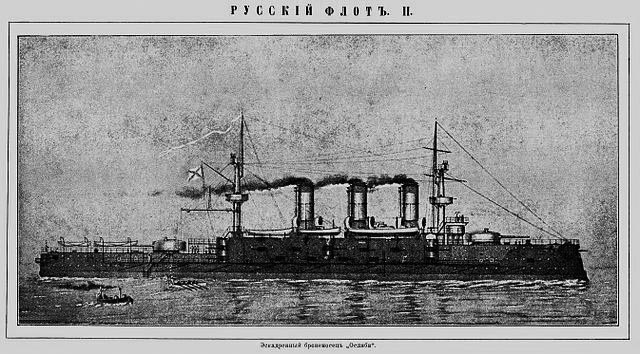
The defeat of the Crimean War in 1854–55 had long standing consequences for the Russian Navy, which made General Admiral Grand Duke Konstantin Nikolayevich realizing than rather than trying to compete with Great Britain and outbuilt the Royal Navy (or France for that matter), it was better to limit the fleet to a defensive strategy first, both for peacetime and as deterrent in wartime.
His take on the popular “guerre de course” or commerce-raiding strategy already embraces by France meant Russia was to instead attack the Empires of Britain or France. Influenced by the latter’s “jeune ecole” thoeries, it found it better to built a serie of fast, long-range armored cruisers. Already, Rossia and Rurik showed the way, and were taken very seriously by the Royal Navy, and only confirmed France in its own assumptions.
The British indeed soon responded with the Centurion class battleships “cruiser-killers” especially tailored to match them. The Russians in turned answered with three battleships to counter the Centurion class. This was the start of the Peresvet class development, fast battleships designed to support the armored cruisers. High speed and long range soon became the prime requirements, above even an heavy armament or armor, as the 2nd class battleships of the Centurion class were more lightly armed than usual with 10-in guns.
As design progressed, many changed were made, and it was followed even during construction by more, delaying her completion by a year. It was notably decided to revise their secondary armament, which went from eight 6-inch (152 mm) considered too slow-firing, completed by five 4.7-inch (119 mm) guns, faster, but making a mixed battery difficult to manage by artillery spotters, to a more uniform batteru of eleven 6-inch guns plus the usual anti-torpedo boats light guns. Only two ships were originally planned, to act with Rossia and Rurik, but a third was ordered just to keep the Baltic Works busy until they could receive a new design. This would the Oslyaba, destined for the Baltic sea fleet, which was amazingly completed before the second ship, depite having being laid down three years after. This tells volume after the design revision practices in the Russian admiralty.
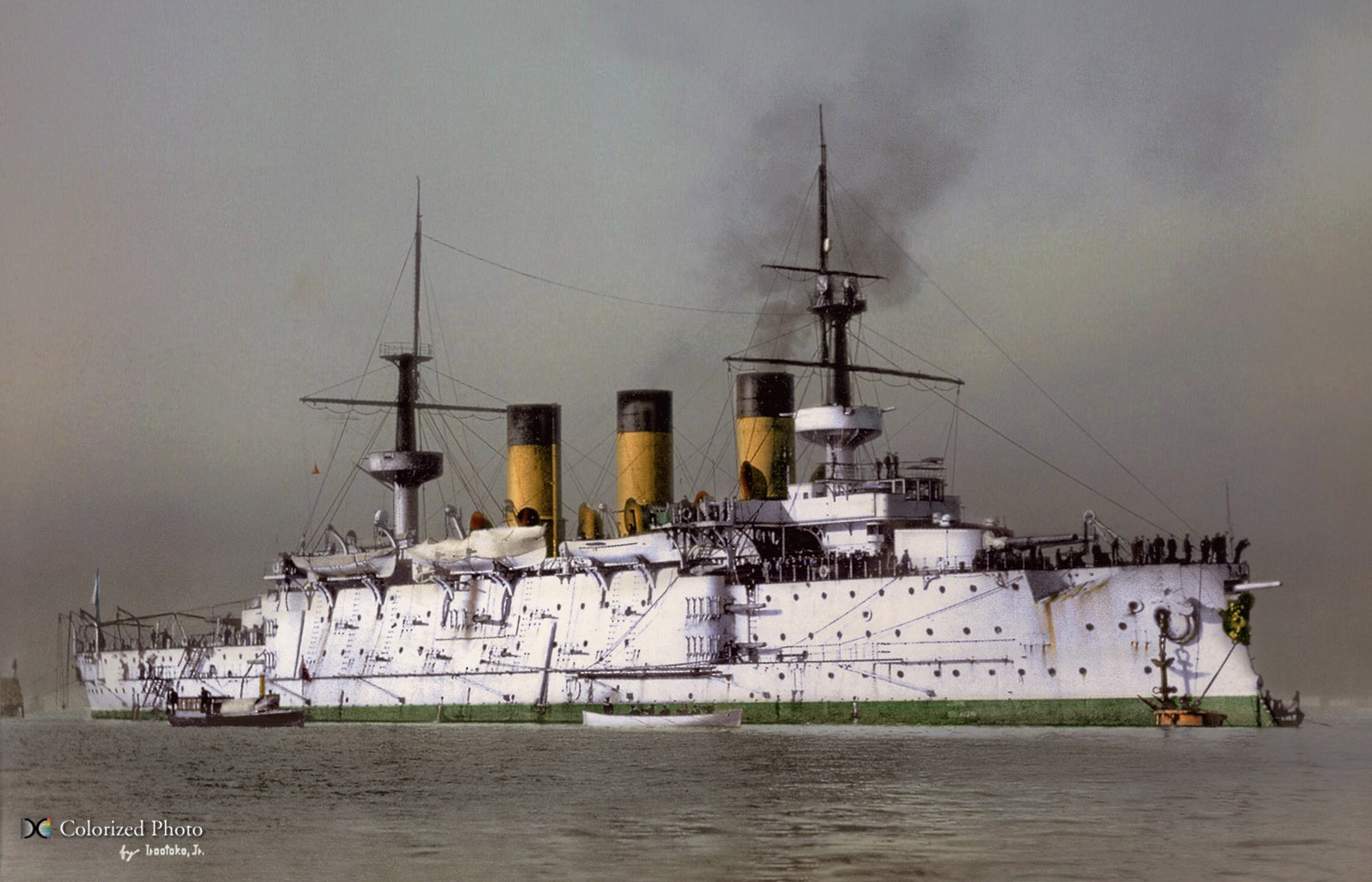
Peresvet, as colorized by Irootoko Jr. (cc)
Detailed design and construction
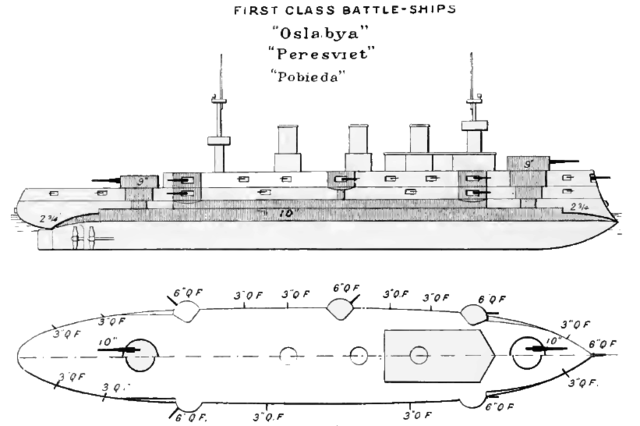
Brassey’s scheme, Peresviet
Hull construction and other details
The Peresvet-class ships had a 434 feet 5 inches (132.4 m) long hull, 71 feet 6 inches (21.8 m) in beam, with a 26 feet 3 inches (8.0 m) draft. They displaced 12,674 long tons (12,877 t). Due to multiple addition they soon had the same problem as many other Russian battleships of the time, being up to 1,700 long tons overweight, reaching 13,320–14,408 long tons overall.
The hull was treated by biofouling, and sheathed with wood and copper (not on Pobeda to save weight). All three had some ASW protection with a double bottom divided into 10 watertight transverse bulkheads. The machinery was separated from the side by a centerline bulkhead in the forward engine rooms, ensuring both could not be flooded at once. Complement as designed was 27 officers and 744 enlisted men.
Armour protection
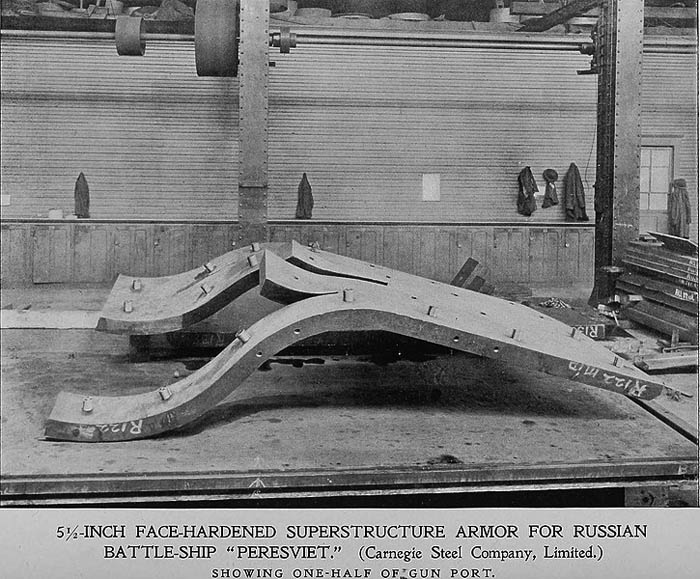
Harvey armoure being cast in the USA for Perseviet
Harvey armor was used initially for the first two ships. The armored vertical surfaces used it, except for the gun turrets and barbettes, in Krupp armor. The third ship, Pobeda, had only Krupp armor all over:
-Waterline armor belt: 9 inches (229 mm) on 312 feet (95.1 m) long, 7 feet 9 inches (2.4 m) high
-Magazines: 7 inches (178 mm)
-Belt tarepered down to 5 inches (127 mm) over the machinery spaces
-Same, 4 inches (102 mm) over the magazines.
-Upper belt 36 inches (914.4 mm) high above the waterline.
-Uppper belt amidship armor strake 4 in, on 188 feet (57.3 m).
-Transverse bulkheads 7 inches (180 mm). Both ends unprotected.
-Eliminated on Pobeda to save weight but 4-in armor plates on both ends.
-Upper belt closed off by 4-in angled transverse bulkheads.
The ships were so overweight that the belt was submerged but with 14 inches (356 mm) exposed and completely submerged at full load on Peresvet and 3 inches on Oslyaba normal load.
-Gun turrets, sides 9 in (240 mm) thick, roofs 2.5 inches (64 mm)
-Supporting tubes 8 inches (203 mm).
-6 in guns Casemate faces 5-in thick, rear 2-inch (51 mm)
-Casemate ends 5-in transverse bulkheads.
-75 mm guns bulkheads 0.75 inches (19 mm).
-Forward, aft conning towers 6 inches or 9-inch sides (two later ships).
-Communications tube 3 inches from CT to armored deck.
-Central armored citadel 1.46-inch (37 mm)
-Structural steel deck plating 0.75-inch
-Slopes to the lower edge, waterline belt 2.5 inches
-Fore and aft armored deck 2.25-inch (57 mm) over 1 inch (25 mm) deck plating.
To spare weight the latter was made of mild steel but Pobeda had it in chrome-nickel steel alloy.
Powerplant
All three Peresvet class battleship were designed for speed, and the powerplant consisted in three vertical triple-expansion steam engines driving each a propeller shaft. In total, these three VTEs were fed by no less than 30 Belleville boilers.
This powerplant was rated total to 14,500 indicated horsepower (10,813 kW) on forced draft. As designed, these battleships were supposed to reach a top speed of 18 knots (33 km/h; 21 mph), but they slightly exceeded their specifications on trials. Top speeds achieved were between 18.3 and 18.5 knots based on 14,532 to 15,578 indicated horsepower.
For autonomy, they carried 2,060 long tons (2,090 t) of coal, so that they could reach 6,200 nautical miles (11,500 km; 7,100 mi) at 10 knots. Electrical power onboard rested on four steam-driven dynamos providing a total of 555 kilowatts (744 hp).
Armament
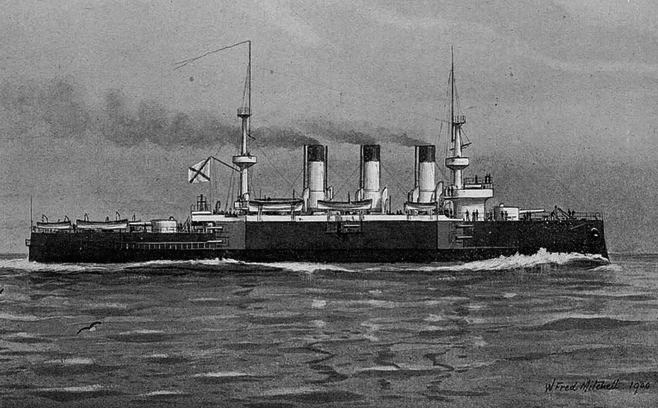
Depiction on Brassey’s naval annual
Main battery
-Four 10-inch (254 mm)/45 in two pairs, on electrically powered mounts, forward and aft at deck level.
These soon ran into many development issues, and were too weak to used a full-strength charge, cracking and overheating. They were reworked while the charge was reduced, delaying their armament.
Peresvet and Oslyabya original gun model had a +35° elevation. Thise onobeda were limited to +25°. Rate of fire was 40 seconds per shot, at least on paper. In practice this was one per minute at best. In all, 75 shells were carried per gun,
with either a 496-pound (225.2 kg) shell (2,270 ft/s, 692 m/s), or on Pobeda, 2,600 ft/s (790 m/s). At just +6° range was 8,760 yards (8,010 m)
Secondary armament
The Peresvet-class battleships were given eleven 6-inch French Canet guns, Model 1891 QF, 40 caliber. Ten were mounted in side hull casemates, including six in double ones, and some underneath the forecastle, as bow chaser. They were provided each with 220 rounds, the latter weighting 91 pounds (41.4 kg) (muzzle velocity 2,600 ft/s, 792.5 m/s). Max range was 12,602 yards (11,523 m) at +20°.
Light guns
Close-range defense rested on twenty quick-firing (QF) 75 mm (3.0 in) French Canet guns, Model 1891: Eight were mounted in embrasures in the hull, four on the main deck, four on the battery deck, four at superstructure’s forecastle deck corners.
300 rounds were carried for each gun, which had a muzzle velocity of 2,830 ft/s, with 10.8-pound (4.91 kg) shells. These guns had a range of 8,606 yards at +20°.
Twenty QF 47-millimeter (1.9 in) Hotchkiss guns former the intermediate light range artillery, all in hull embrasures and superstructure, including the fighting tops (efour each). They each had a reserve of 810 rounds, all 3.2-pound (1.5 kg) shells.
At last he lowest range was covered by twelve 37 mm (1.5 in) Hotchkiss guns placed between the 47 mm guns on the forecastle deck, firing 1.1-pound (0.50 kg) shells at 1,540 ft/s (470 m/s).
In 1904, the armament comprised twenty 75mm/48 Canet guns (3 in), two 64mm/17 Baranovski guns (used for landing parties), twenty 47mm/40 Hotchkiss and eight 37mm/20 Hotchkiss guns.
Torpedoes
Thse battleships were equipped with five 15-inch (381 mm) torpedo tubes: Two above water, bow and stern, plus two surface broadside tubes and two underwater tubes. 12 torpedoes were carried in reloads. The Persevet ships were also given deck rails to carry 45 mines. They were only destined to secure their anchorage in remote areas, but they did not had anti-torpedo nets.
Fire control systems
The Persevet class battleships had Liuzhol stadiametric rangefinders, simple early systems in which the operator approached manually two vertical points when focusing on an enemy ship, using its waterline and crow’s nest to estimate its range. It was a trusted system, albeit not stabilized nor counting on heavy weather, bad visibility or speed estimation.
The gunnery officer consulted his references to calculate the range and proper elevation, deflection to hit the target, all by hand. He transmitted then his commands via a Geisler electro-mechanical fire-control transmission to either a signular gun or the whole turret. Oslyabya received the more modern Perepelkin telescopic sights but their crews lacked training to operate them when the ship was sent to the far east.
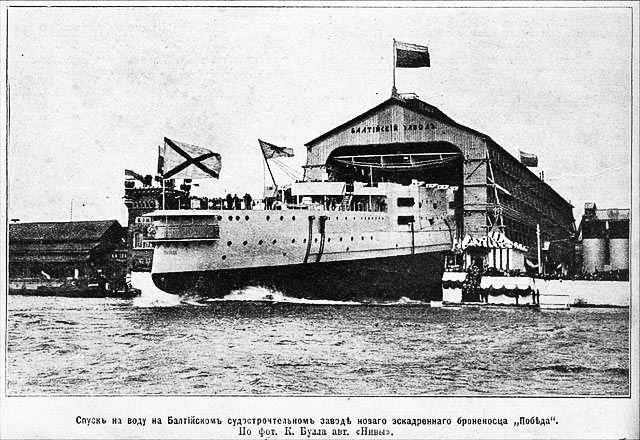
Launch of Pobeda at the Baltic Shipyard
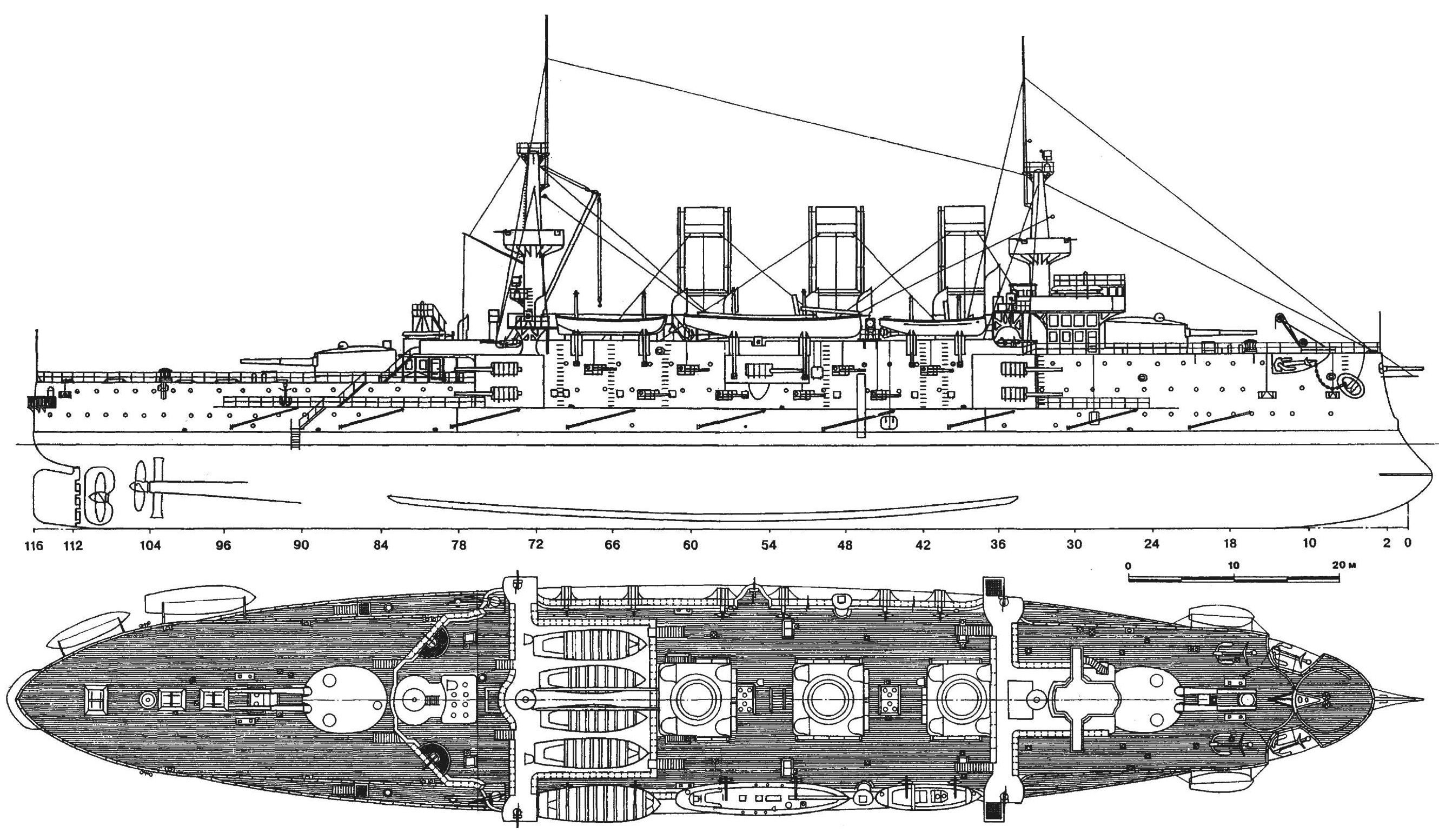
Profile 2 views HD (Kombrig kit)
Peresvet class specifications |
|
| Dimensions | 107 x 20.4 x 8.4m (351 x 67 ft x 27 ft 7 in) |
| Displacement | 10,206 long tons (10,370 t) standard |
| Crew | 24 +417 |
| Propulsion | 2 shafts TE engines, 12 Cyl. boilers, 9000 ihp |
| Speed | 15 knots (28 km/h; 17 mph) (16 knots as designed) |
| Range | 3,050 nmi (5,650 km; 3,510 mi) at 10 knots |
| Armament | 4 x 305 (2×2), 8 x 152, 14 x 47 mm, 12 x 37 mm, 6 TT 450 mm |
| Armor | Waterline belt: 12–16 in (305–406 mm), Casemate: 5 in (127 mm), Turrets: 12 in (305 mm), CT: 10 in (254 mm) |
General assessment of the class
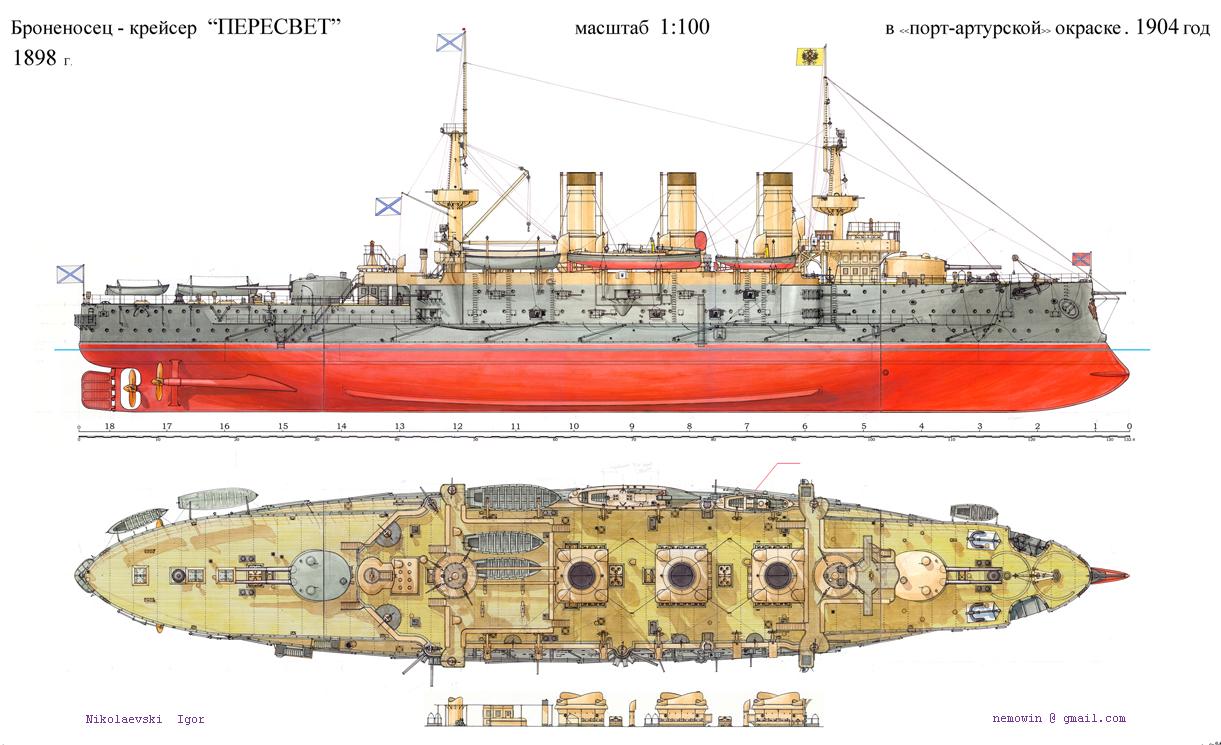
Profile color of PERESVET in 1904, 1st Pacific Sqn. by Igor Nikolaevski
The Persevet class were essentially compromised battleships, large and bulky and yet weakly armed, fast, but only of three knots, which never fulfill the role they were designed for: Protecting the armoured cruisers Rurik and Gromoboi, fight the British Centurion class battleships. Instead, due to their long completion, the context changed drastically and they ended facing the Japanese Navy, testing unconventional warfare, notably by the surprise night attack of Port Arthur, a distant relative to Pearl Harbor. They lukewarm performance at the Yellow sea revealed their identified design problems, being overweight with an armoured belt way too low and lack of heavy firepower.
During the Battle of Port Arthur (February 1904) Peresvet was not hit, but Pobeda was hit amidships with little damage. Pobeda however struck a mine during the squadron’s sortie (13 April) and was repaired for almost two months. Both, stuck in harbor, were soon deprived of their anti-torpedo boat guns and even secondary armament during the summer, to bolster the port’s defense, but they participated in the Battle of the Yellow Sea on 10 August 1904 with their main armament. Pobeda was received 11 large-caliber hits and resisted well, but not Peresvet, hit 39 times and suffering considerable flooding. Back in Port Arthur, they were stripped of even more secondary guns, but when the Japanese eventually captured the hills overlooking the harbor in November 1904 (suffering massive casualties nevertheless), they brought their 280 mm (11 in) siege guns to bear and soon fired from angled never throught of by naval engineers, wrecking both Russian ships. Pobeda sank on 7 December 1904 and Peresvet was scuttled.
Oslyabya led the Second Division of the squadron during the battle of Tushima, and became almost the sole target of the whole Japanese line during the early part of the battle. Many hits ended along her waterline, still too low despite her design revision, caused extensive flooding. Counteracting list destroyed her stability and she eventually sank just an hour after the first shot, being the first modern battleship to be sunk solely by gunfire.
Name trivia: Peresvet was named after Alexander Peresvet, a Russian monk hero, fighting the Golden Horde at the Battle of Kulikovo in 1380. Pobeda meant “victory” and Oslyabya after “Rodion Oslyabya”, another 14th-century monk of the Troitse-Sergiyeva Lavra, also an hero of the Battle of Kulikovo in 1380.
Suwo and Sagami (the captured Port arthur battleships) served in the IJN for many years, rearmed notably with secondary and tertiary Japanese guns (which were of British, not French standard), until Suwo was resold to the Russians. They generally gave satisfaction and could have been still around as training ships in WW2 if it was not for the Washington treaty.
Read More/src:
Books
Conway’s all the world’ fighting ships 1860-1905
Campbell, N. J. M. (1978). Preston, Antony (ed.). The Battle of Tsu-Shima, Conway Maritime Press.
Forczyk, Robert (2009). Russian Battleship vs Japanese Battleship, Yellow Sea 1904–05. Osprey.
Krestyaninov, Vasiliy (1998). “Броненосцы типа “Пересвет” (Battleships of the “Peresvet” class)”.
McLaughlin, Stephen (2003). Russian & Soviet Battleships. Annapolis
Pleshakov, Constatine (2002). The Tsar’s Last Armada: The Epic Voyage to the Battle of Tsushima. Basic Books NY
Schrad, Mark Lawrence (2014). Vodka Politics: Alcohol, Autocracy, and the Secret History of the Russian State. Oxford
Silverstone, Paul H. (1984). Directory of the World’s Capital Ships. New York: Hippocrene Books.
Taras, Alexander (2000). Ships of the Imperial Russian Navy 1892–1917, Library of Military History
Links
Archives books: The star’s last armada, Pleshakov, Konstantin 2002
Conway’s all the world’s fighting ships 1860-1905 (1979)
Sagami/Peresvet on wrecksite.eu
On scientific american 1904 (jstor.org)
Model kits
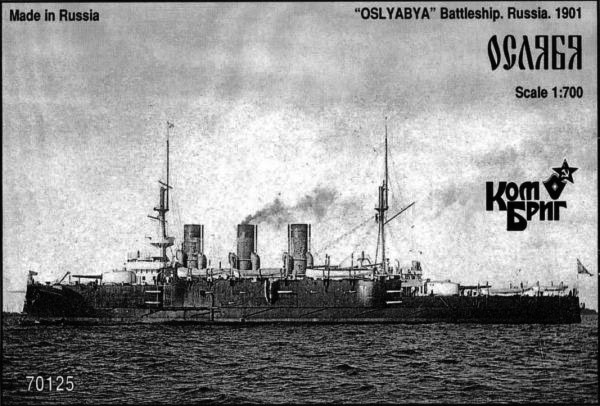
Oslyabya, Kombrig kit 1/700
Combrig 1:350, Modelkrak 1:700, Digital Navy 1:250.
On scalemates
On steelnavy.com
1st Pacific Sqn livery
On tirbosquid.com 3D model
Levieries examples, before the war, 1st and second pacific Sqn.
The Persevet class in action
 Peresvet
Peresvet
In the Russian Imperial Pacific Fleet
Peresvet (or Peresviet) was laid down on 21 November 1895, same day as her sister ship Olsyabya, in New Admiralty Works, Saint Petersburg, launched on 19 May 1898 but not completed until July 1901 due to frequent changes and at a cost of 10,540,000 rubles. She entered service in August 1901, to be almost immediately sent to Port Arthur, in October 1901, after little training. En route, perhaps because of this lack of skills, she ran aground of Langeland Island, Danish Great Belt, on 1 November. Damaged was light and she could free herself quickly. After her long trip, punctuated by many coaling stops, she became flagship of the newly created Pacific Squadron, second-in-command (Rear Admiral Prince Pavel Ukhtomsky). Her peacetime service was spent training, from 1902 to 1904, with a few sorties in nearby Korea and Japan, or along the Chinese coast.
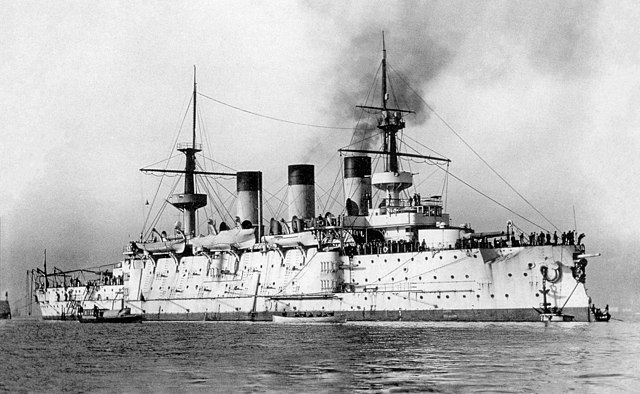
In 1901
Japanese victory at Yalu in 1894–95 (against a superior Beiyang fleet) increased confidence of Japan upon the continuation of its territorial extension and influence over the whole region. The peace negociation attribution of Port Arthur to the Russian soon rose tensions between Russia and Japan as both wanted control over resources-rich Manchuria, and Korea. The Russian failure to withdraw its troops from Manchuria in October 1903 as promised only fuelled Japanese resentment, and negotiations, which started in 1901, were jeopardized ad the Russians were slow and uncertain in their replies, not yet deciding how to resolve ths territorial disputes. Meanwhile, the Japan government grew impatient, and interpreted these Russian dispomatic blunders as deliberate prevarications, only designed to buy time, and complete Russian armament programs and fortify the whole region.
The final straw was the announcement of Russian timber concessions in northern Korea, followed by a strict refusal to acknowledge Japanese interests in Manchuria, assorted with drastic conditions over Japanese interests in Korea. At the time, there was an alliance with Britain since 1902, seen as the most likely potential adversary of the british Empire at the time. These new vexation led the Japanese government to decide by December 1903 was was the only course of action. Troopships were assembled for a full landng in Korea, and to drive out Russian troops, which in response had the Pacific Squadron redeployed in the outer harbor in order to react more quickly and interecept Japanese convoys.
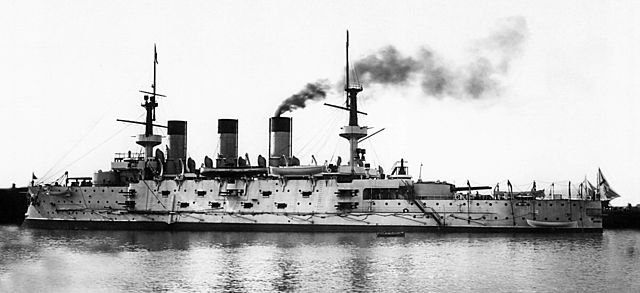
On the night of 8/9 February 1904, the Japanese surprise attack on Port Arthur was intended to torpedo all ptsent ships in the harbor, but it went not as well as planned: Peresvet was not hit by the initial torpedo-boat run. Steam was raised and she sortied to intercept the Combined Fleet (Vice Admiral Tōgō Heihachirō). The latter expected more success from the surprise attack, but the Russian had in fact little damage and recovered quickly, regrouped for leading a well-coordinated counter-attack.
The protected cruiser Boyarin, screening outside, was the first spotted, and Tōgō started to attack Russian coastal defenses with his main armament, engage incoming Russian ships with his secondaries. This firepower Splitting however was a poor decision: The best secondary guns of the Japanese, their 8 and 6 inches inflicted little damage to approaching Russian ships, soon able to take a line and broadside with all their armament their Japanese opponents, inflicting some damage. Peresvet was hit three times, but her armour cope well, during the whole engagement. The whole Russian battleline however decided to get back to port.
On 22 March, Peresvet started to firing indirectly at the Japanese ships, still bombarding the harbor. On 26 March, she was outside Port Arthur when accidentally colliding with the battleship Sevastopol, but damage was light. Peresvet took part in another action on 13 April: Tōgō indeed successfully lured out a portion of the Pacific Squadron, notably Vice Admiral Stepan Makarov’s Petropavlovsk, the fleet’s flagship. When turning back, his battleship struck a recently laid Japanese minefield, and she sank very quickly after the explosion of a magazine. Tōgō capitalize don this and resumed his long-range bombardment of Port arthur, expecting anoyther Russian sortie. Peresvet however organized her indirect fire better, using well placed observers, and managed to hit the armored cruiser Nisshin when she was closing on Port Arthur.
Peresvet sailed with eventually with the whole Pacific Squadron on 23 June, in order to reach Vladivostok, under command of Rear Admiral Wilgelm Vitgeft. But the well-placed Japanese’s own accuracte, withering fire soon took its toll and forced Vitgeft to order a return to Port Arthur, not willing to engage it in a night battle. Peresvet spent her time afterwards shelling Japanese positions besieging Port Arthur on 28 July, but she had her light guns removed this summer to bolster the defenses. At the end of the summer, she had lost three 6-inch, two 3-in, two 3-pdr, four 1-pdr guns. The Japanese eventually succeeded in bringing their heavy 4.7-inch (120 mm) guns in a favourable position and fired on the harbor on 9 August, hitting Perservet, but with moderate damage.
A direct order from Tsar Nicholas II combined with the progression of the Japanese in their siege operation eventually forced Vitgeft to try a last attempt to reach Vladivostok in full force. His squadron was made ready and sortied on the first hours of 10 August. At 12:25 a screen of Japanese cruisers spotted them, communicating this to the Combined Fleet. This soon developed into the main Battle of the Yellow Sea.
Peresvet during this engagement was fourth in line, not seriously damaged during the early phase, a long-range duel in parallel lines. Around 18:00 however she had her topmasts destroyed by lucky 12-inch shells from IJN Asahi, one more penetrating Tsesarevich’s conning tower. As flagship this luckier ship killed Vitgeft outright as the captain, and the lead ship soon came to a dead stop after a sharp turn. Not knowing about this event all other ships thought it was a manoeuver and started to veer away too. Peresvet maneuvered wildly to avoid hitting the flagship, but was not in the best position to engage the Japanese.
The total confusion was followed by Togo ordering to focus on each ship one by one, targeting Tsesarevich until she was completely in flames, then Retvizan, and eventually Peresvet. The latter’s captain wanted to make a difference and decided to boldly charged Tōgō’s to divert Japanese shellfire and save the rest of the fleet. But the Japanese battleline badly damaged Peresvet, which was forced away. Ukhtomsky, now in command, tried to signal to all the ships following him back to Port Arthur, but this was only gradually recognized. Peresvet meanwhile took 39 hits of all calibers, killing 13, wounding 69. But most importatly, her forward 10-inch turret was knocked out and she had considerable flooding, with compartments in the double bottom counterflooded in response. This restored some stability and save her as she limped back to Port. Repairs followed, not completed until late September.
On 11 August, the bettered Russian squadron was in dire straits: The Third Army (Baron Nogi Maresuke) achieved his complete encirclement and trying to take crucial hills, so Rear Admiral Robert N. Viren, decided continue bolster the defense, stripping the ships of men and guns. On 20–22 September 203 Hill overlooking the harbor was taken and soon, heavy guns were brought on top. Peresvet, Retvizan, Poltava and the gunboat Bobr however soon were ordered to bombarded the hill’s opposite face -with little success- to defend the hill. The Japanese meanwhile started an blind artillery barrage into the harbor on 30 September. They managed to hit Peresvet with six 5.9-inch and 4.7-inch shells, as well as the following day.
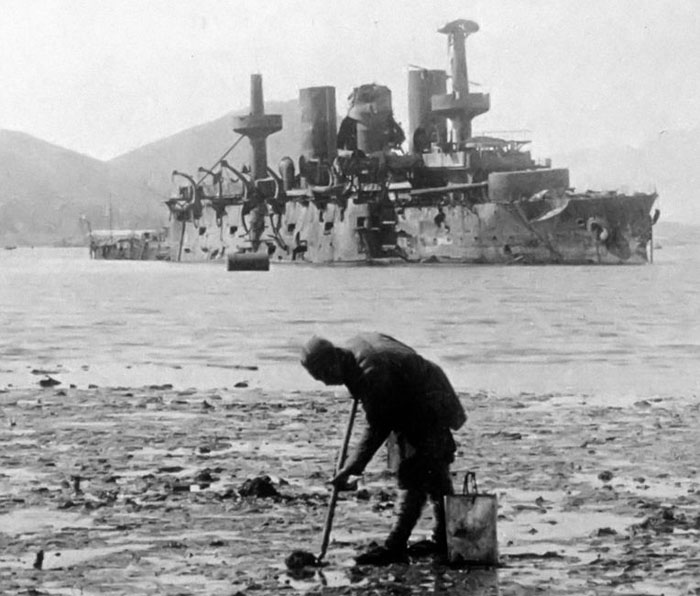
Peresviet, sunk in Port Arthur, 1905
On 2 October, they manage to bring forward to range their heaviest howitzers, and Persevet was hit by nine 11-inch (280 mm) shells in succession; Fortunately, they still failed to penetrate her deck armor (notably because they were “soft” low-velocity HE shells). However damage on all unpotected superstructure was considerable. The funnels, bridge, masts, were crippled. Next, Hill 203 fell on 5 December so allowing to bring siege guns on top, now in full view of the Russian ships. Peresvet took an accurate fire, being hit many times. The situation being hopeless, her captain decided to scuttle her in order, not to be recover by the Japanese, but in shallow water. On 7 December 1904, valves were opened and she sank upright, still mostly emerging.
 Peresvet as IJN Sagami (1908-1916)
Peresvet as IJN Sagami (1908-1916)
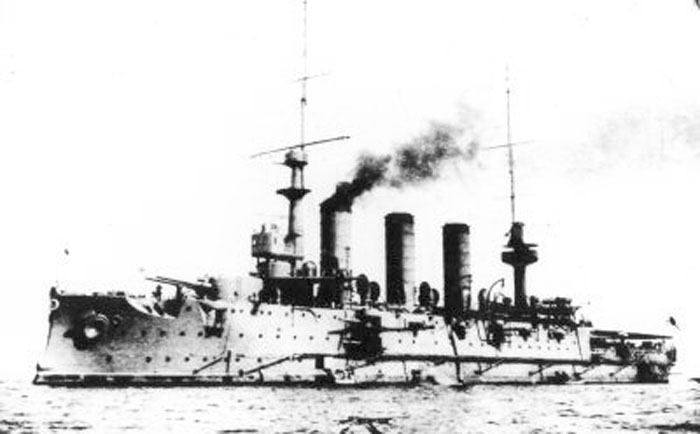
Soon the siege was over and the relieving second pacific squadron arrived too late, ambushed an destroyed at Tsushima. The event provoke peace negociations ending with a humiliating defeat for the Russian leading to widespread discontent and a famous mutiny. Peresvet was nevertheless refloated by Japanese engineers, on 29 June 1905. She managed to steam under her own power to Sasebo Naval Arsenal for extensive repairs and standardization. She arrived on 25 August 1905 and renamed Sagami after the ancient province, reclassified as first-class battleship on 25 August. Newt she was moved to Yokosuka Naval Arsenal on 16 September and entered the drydock on 30 September. Repairs and modifications were quite extensive and went on until 20 July 1908, so about three years. She participated in the review of captured ships on 23 October.
Japanese engineers soon identify her problems and stared to improve her stability: They decided to remove her forward fighting top for a simpler pole mast. She was rearmed with four 10-inch/45 caliber to IJN standards, as well as ten 6-inch guns plus sixteen QF 12-pounder 12 cwt Vickers standard. She kept her surface torpedo tubes, but they wree changed for Japanese 18-inch model. Her crew rose to 791 officers and men. She greeted notably the American “Great White Fleet” when visiting Japan in late 1908. In subsequent training exercizes, she always played the “enemy” ship and participated in the 1909, 1910, 1911 annual fleet maneuvers. Reclassified as a first-class coastal defense ship on 28 August 1912 her career started to be quieter.
 Peresvet back in Russian hands (1916)
Peresvet back in Russian hands (1916)
In mid-1916, the Russian government realized it needed to bolster the Baltic and Black Seas, and since Japan was allied to UK, it was found allied to the triple entente as well. Russia asked the Japanese government to sell them back Sagami, and other ex-Russian warships in March 1916.
Sagami left Japan and arrived in Vladivostok on 3 April 1916, with a ceremony and crew transfer. She was renamed Peresvet and classified as an armored cruiser on the 5 april, prepared for a long trip back to the west. However she ran aground on 23 May, while conducting trials. The IJN refloatedher on 9 July and she eventually started repairs in Maizuru Naval Arsenal, from 30 July. She only was ready to sail west from opean 18 October 1916. The admiralty now wanted her to be posted with the White Sea Fleet. She crossed the South China eat, east indies, Indian ocean, then entered the Suez canal, entering Port Said for machinery repairs in early 1917. On 4 January 1917 she was underway, some 10 nautical miles north of Port Said when stricking two mines laid by the German submarine SM U-73. Her boiler rooms holed, she catch fire while flooding progressed quickly and eventually sank, bringing with her some 116 or up to 167 men depending on the sources.
 Oslyabya
Oslyabya
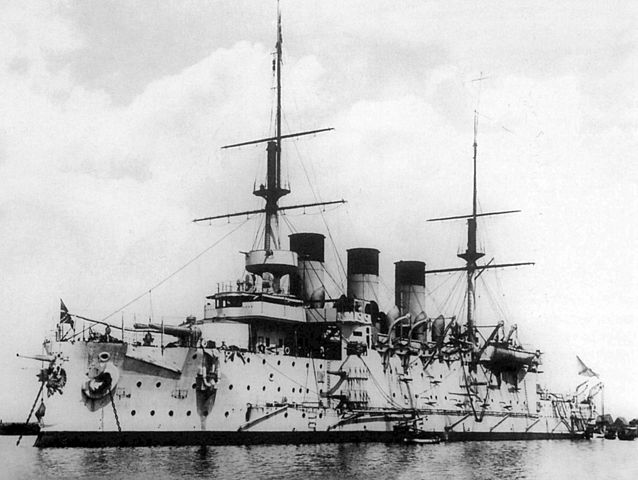
As built, 1903
Named after Rodion Oslyabya, the Troitse-Sergiyeva Lavra Monk hero of Kulikovo was built at the New Admiralty Shipyard in Saint Petersburg, from 21 November 1895 to her launch on 8 November 1898. The Shipyard’s delays had her completed only in 1903, at a cost of 11,340,000 rubles. She headed after little training to Port Arthur, on 7 August 1903 with Bayan. However she ran aground in the Strait of Gibraltar, on 21 August, repaired until late November in Algeria and La Spezia in Italy, proceeded again to the Far East, until recalled to rush back to join the Baltic Fleet on 12 February 1904 as the Russo-Japanese War just broke up. It was indeed intended to equip her with more modern equipment. Back to St. Petersburg in April 1904 she received indeed brand new 4.5-foot (1.4 m) Barr & Stroud rangefinders, plus telescopic gun sights, a new ventilation system, and a modern Telefunken radio equipment, making her the most modern of all three Persvet class.
Early Career
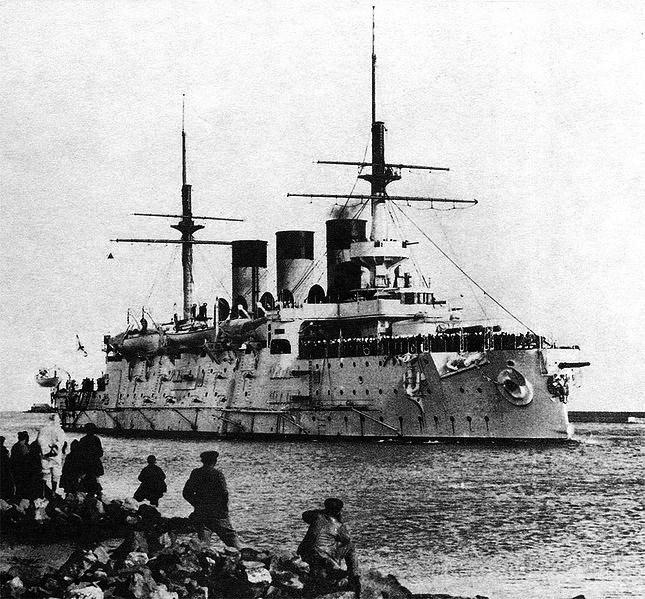
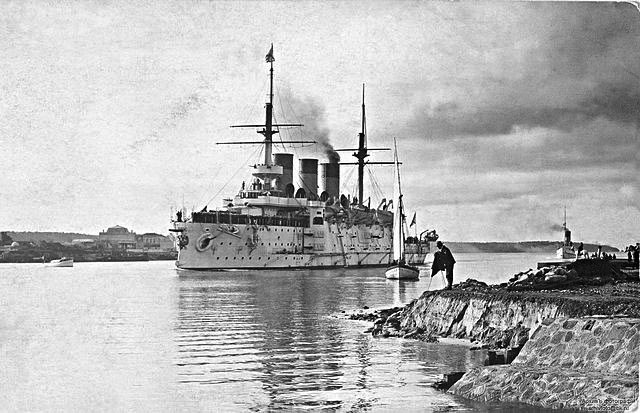
Oslyabya in Bizerte, 1904
She was intended to leave for the Far East as reinforement, a strategy first drafted in 1897 in case of war with, the First Pacific Squadron remaining if possible in Port Arthur, avoiding a battle until reinforcements arrived, and a pincer made with the Vladivostok fleet.
On 15 October 1904, Oslyabya departed at last Libau for Port Arthur, becoming Fölkersam’s flagship, taking the head of all Second Pacific Squadron ships under overall command of Vice Admiral Zinovy Rozhestvensky. Their 18,000 mile (29,000 km) journey took quite a strain on the coal-powered fleet and experienced many issues on their way, including total confusion when they fired and sunk by error British trawlers in the mist, or collission in the Skagerrak already between Oslyabya and the destroyer Buistri.
While in Tangier on 28 October, Rozhestvensky ordered a split of his forces, Von Fölkersam’s squadron going through the Suez canal, the Red Sea, making a rendezvous in Madagascar. Rozhestvensky Oslyabya sailed with the rest of the main force to the “long trip”, down the African horn, rounding it up to Nosy Be island, NW Madagascar, arriving on 9 January 1905. The reunited squadron rested there for two months while coaling arrangements were made for the last trip. But by that time, they received news that Port Arthur had surrendered, so he decided to head for Camranh Bay in French Indochina to resupply thanks to their alliance. It was on 16 March. They stayed there one more month the slower third Pacific Squadron (Rear Admiral Nikolai Nebogatov).
Reunited on 9 May they prepared to head for Vladivostok on 14 May, reorganized on their way into three tactical divisions: First: Four Borodino-class battleships (Rozhestvensky). Second: Oslyabya, Navarin, Sissoi Veliky, Admiral Nakhimov (von Fölkersam). Third: Knyaz Suvorov, and Imperator Aleksandr III (Nebogatov). Von Fölkersam was ill with cancer and passed out on 26 May, replaced by Oslyabya’s Captain 1st Rank Vladimir Ber.
Oslyabya at the Battle of Tsushima
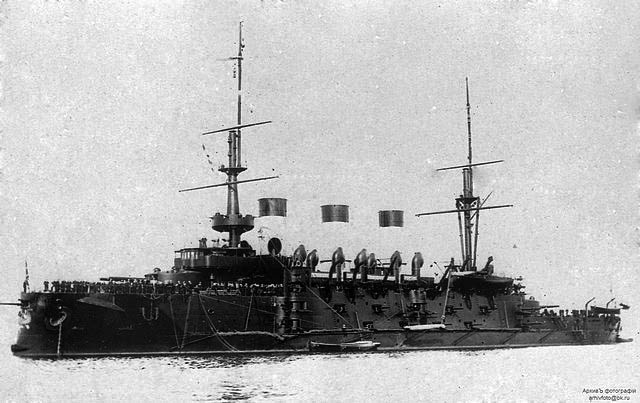
Oslyabya was, like the Borodinos perhaps overweight, resulting in a lower than normal draft and therefore, armored belt. it was due to the mass of coal and other supplies carried for the trip. Not only it gravely compromised their protection, but also their stability as gun platforms. Oslyabya’s main armor belt was indeed already fully submerged at full load, so presumably more with extra coal and supplies. This left only the upper 4-inch upper armor above the waterline.
On 27 May she was spotted like the rest of the squadron, awaited by the Japanese combined fleet in the Korea Strait. Oslyabya led Rear Admiral Nebogatov’s reorganized Second Division (Knyaz Suvorov, Oslyabya, Imperator Aleksandr III and Borodino.), targeted of at least two Japanese battleships and two armored cruisers from 14:10. Rozhestvensky, from line ahead formation, ordered parallel columns, Oslyabya almost stopping to not colide during the manoeuver with the battleship Oryol, last of Rozhestvensky’s 1st division.
Shells knocking out her main rangefinder, severing cables connecting the guns to the Geisler fire-control system and wounding or killing the gunnery staff. The mainmast was shot way and fell, the forward gun turret was knocked out a well, then three port side 6-in guns. Splinters also entered her conning tower, killing the quartermaster and having the rest if the staff badly wounded. Eventually, Oslyabya fell out of line, on starboard, soon engaged by the concentrated fire of six Japanese armored cruisers, now at short range.
Meanwhile she continued receiving 12-in caliber shells on her waterline, having major flooding quikcly and starting sinking by the bow as she moved forward. She also started to list to port, and engineers attempting to counter-flood her starboard forward magazine, but this added more displacement forward, making her ploughing even more, to the point her entire deck level above the waterline disappeared undesea, and her stability only went from bad to worse. She listed 12 degrees at 14:20, and only when her funnels touched the water around 15:10, Captain Ber ordered to abandon ship, but it was already too late: She sank a just a few minutes, with 470 men onboard, including Captain Ber.
 Pobeda
Pobeda
Early Pacific career
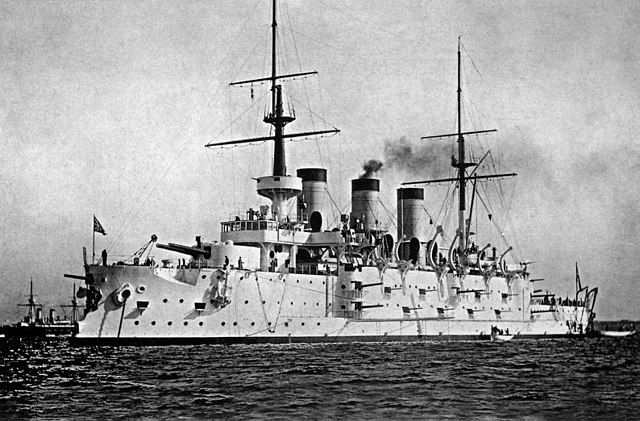
Pobeda on the kronstadt roadstead in 1901
Pobeda (“Victory”) or Pobieda (Conways) was the last ship of the class, ordered much later. She was built at the Baltic Works shipyards (Saint Petersburg) unlike the two others, from 30 May 1898 (the formal keel-laying ceremony was held on 21 February 1899 !), launched on 10 May 1900, towed to Kronstadt for fitting out work on 31 August 1901, followed with machinery trials in October 1901, but she was still completed the next year. Sailing to Reval (Tallinn) on 1st August in time for an naval review in front of the Tsar’s cousin, the German Kaiser Wilhelm II. Pobeda completed her artillery trials and officially entered service in October 1902, and only officially accepted for service on 10 March 1903, costing 10,050,000 rubles.
She sailed from Libau on 13 November 1902 to Port Arthur, arriving on 13 June 1903, assigned to the Pacific Squadron. She barely had to time to train therefore until hostilities broke with Japan, just a mere eight months.
The Russo-Japanese war
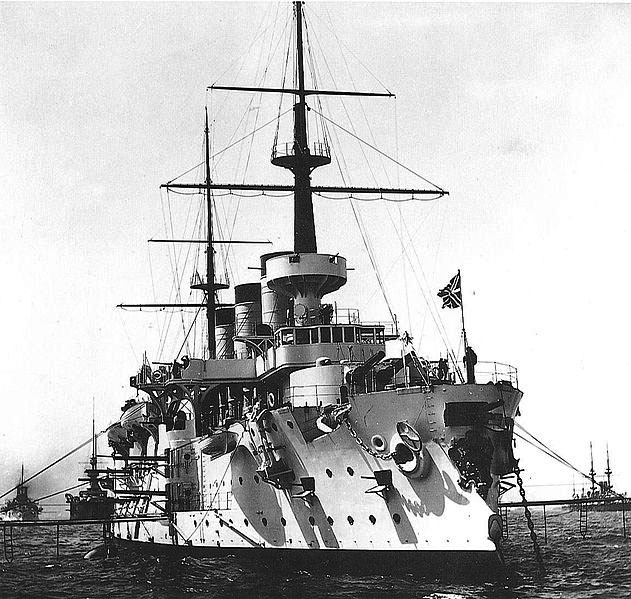
Pobeda, date unknown
On the night of 8/9 February 1904, the IJN attacked Port Arthur by surprise and torpedo boats managed to fail hitting Pobeda. She was prepared and sortied the following morning. They were met by Vice Admiral Tōgō Heihachirō, which soon took the best firing position as soon as Boyarin, patrolling nearby, was spotted. Tōgō split his fire between the Russian coastal defenses and approaching ships, but the latter started to pound the Japanese to some effect. Pobeda was struck perhaps twice amidships close to the waterline (2 kille, 4 wounded), but without penetration and overall little damage. She then followed the fleet back to Port Arthur.
On 22 March, Pobeda joined a new sortie to repel the Japanese comibined fleet, bombarding Port Arthur’s harbor. Pobeda managed to hit the battleship IJN Fuji once, but again, this sortie was indecisive and all ships were back in port. On 13 April, she was part of the fleet drawn out of the port with Vice Admiral Stepan Makarov’s flagship, the Petropavlovsk. Makarov however, turned back when Petropavlovsk struck a mine and sank quickly. Pobeda also struck a mine herself, but she survived and managed to reach the harbor despite massive floosing and a 11° list. Repairs were completed on 9 June, when already some of her guns were removed to reinforce the perimeter’s defenses: Three 6-inch, two 3-in, one 47 mm, four 37 mm in all were retired.
She participated on 23 June on another abortive attempt to break through and reach Vladivostok under the new fleet commander, Vice Admiral Wilgelm Vitgeft. He turned back as soon as he spotted the Japanese fleet shortly before sunset and did not wanted to try a night battle.
Battle of the Yellow Sea
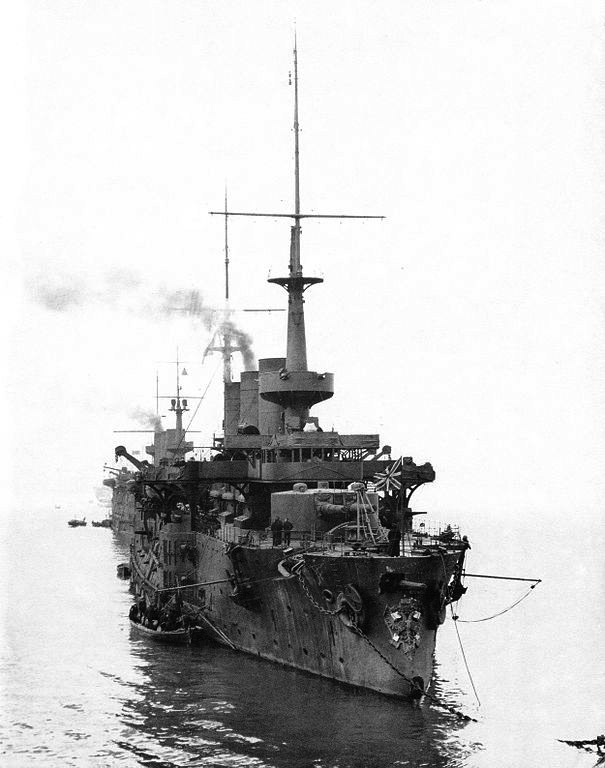
Pobeda in port Arthur
On 9 August the Japanese bombardment intensified and the same day, a direct order to attempt a sortie by the Tsar Nicholas II, forced Vitgeft to try another run to Vladivostok, which started at 12:25 on the 10th, when spotted by Japanese cruisers. Soon, Togo’s Combined Fleet pounced at the Russians, which this time held firm. This developed into Battle of the Yellow Sea. Pobeda was third in line, not seriously damaged during the first long-range duels. At around 18:00, the flagship Tsesarevich took two 12-inch shells from IJN Asahi, killing Vitgeft and causing mayhem in the line. Pobeda maneuvered to avoid hitting her flagship and turned.
As Retvizan charged Tōgō’s battleline, Peresvet followed under the new command of Rear Admiral Prince Pavel Ukhtomsky. The Japanese formed a barrage by “crossing their T” and forced them away, until Ukhtomsky believed it was lost and ordered to follow him back to Port Arthur, a signal only seen late. Pobeda meanwhile took 11 12-in shell hits, killing 4, wounded 29 but her armor managed to remaine intact, and she reached Port Arthur, having one 10-inch gun disabled as well as three 3-in guns as battle damage.
Siege of Port Arthur
Back on 11 August, the Russian squadron only saw with despair Baron Nogi Maresuke’s siege intensifying. The newly appointed commander, Rear Admiral Robert N. Viren, decided to diesmount al the guns he could to massively reinforce the defenses of Port Arthur. Pobeda however was soon like the rest of the ships under Japanese field guns fire, blind fire, and she was struck by several 5.9-inch (150 mm) and 4.7-inch shells, but not causing great damage overall. When 203 Hill fell 5 December, the Japanes raised on top their best guns for more accurate fire. Soon Pobeda was struck by several 28-centimeter (11 in) siege guns, and she took 30 hits in all, causing her sinking in shallow waters, on 7 December. She could not be efficiently scuttled and was left here as her crew evacuated, most joint the last defenders of the perimeter. They surrendered soon afterwards.
As IJN Suwo
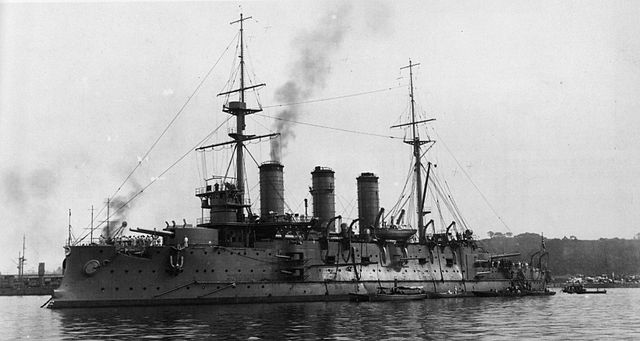
IJN Suwo in Yokosuka, 1908
Pobeda was refloated by Japanese on 17 October 1905, nearly a year after the end of the siege. She was reclassified as a first-class battleship, renamed Suwo on 25 October, (an ancient province), steaming to Sasebo Naval Arsenal, arriving on 16 December for temporary repairs, and then a full reconstruction at Yokosuka Naval Arsenal, from May 1906, until 10 October 1908. Japanese engineers soon recoignised her issues and started to improve he stability, like her sister ship Sagami, by remving her heavy military masts. To stick to Japanese standards, she was rearmed with four 10-inch/45, ten 6-in, sixteen QF 12-pounder 12 cwt (3 in or 76 mm), all licenced Vickers guns. Suwo also received two new above-water 18-inch (450 mm) torpedo tubes. Her Japanese crew was setup at 791 officers and ratings.
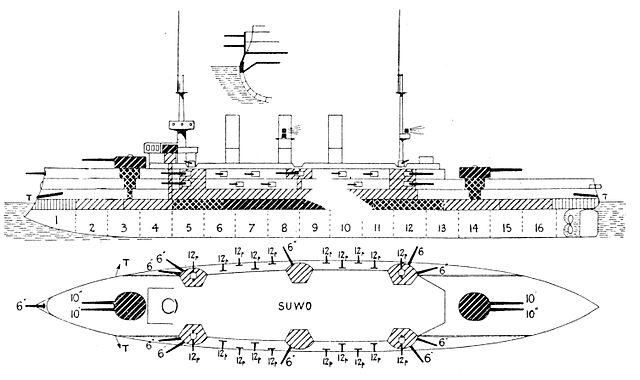
IJN Suwo – Brassey’s rendition
IJN Suwo became a first-class coastal defense ship in August 1912, then training ship for cadets and engineers, as she was no longer up to standards. After the 1st Standing Squadron, in 1914 she was fully reactivated as flagship, 2nd Squadron (Vice Admiral Kato Sadakichi). This squadron sailed out to blockade the German colony of Tsingtao in China. Suwo cooridnated the fleet’s effort and support of the Imperial Japanese Army that eventually captured the city.
Suwo, Tango, HMS Triumph, shelled German fortifications until the Germans surrendered on 7 November 1914. Suwo remained flagship of the Second Squadron, Second Fleet in 1915 and in 1916. By then, with the new upcoming nava programs she was declared surplus and reclassed as a gunnery training ship, based in Yokosuka until November 1918. In April 1922, the Washington Naval Treaty obliged her to be disarmed (which was done at the Kure Naval Arsenal) and her her armor removed. However during this critical operation she experienced a grave stability inbalance and capsized on 13 July. Scrapping was probably done in 1923, other sources claiming she was refloated and used as an utility hulk, then BU up at Kure in 1946 (1922 for Conway).


 Latest Facebook Entry -
Latest Facebook Entry -  X(Tweeter) Naval Encyclopedia's deck archive
X(Tweeter) Naval Encyclopedia's deck archive Instagram (@navalencyc)
Instagram (@navalencyc)





 French Navy
French Navy Royal Navy
Royal Navy Russian Navy
Russian Navy Armada Espanola
Armada Espanola Austrian Navy
Austrian Navy K.u.K. Kriegsmarine
K.u.K. Kriegsmarine Dansk Marine
Dansk Marine Nautiko Hellenon
Nautiko Hellenon Koninklije Marine 1870
Koninklije Marine 1870 Marinha do Brasil
Marinha do Brasil Osmanlı Donanması
Osmanlı Donanması Marina Do Peru
Marina Do Peru Marinha do Portugal
Marinha do Portugal Regia Marina 1870
Regia Marina 1870 Nihhon Kaigun 1870
Nihhon Kaigun 1870 Preußische Marine 1870
Preußische Marine 1870 Russkiy Flot 1870
Russkiy Flot 1870 Svenska marinen
Svenska marinen Søværnet
Søværnet Union Navy
Union Navy Confederate Navy
Confederate Navy Armada de Argentina
Armada de Argentina Imperial Chinese Navy
Imperial Chinese Navy Marinha do Portugal
Marinha do Portugal Mexico
Mexico Kaiserliche Marine
Kaiserliche Marine 1898 US Navy
1898 US Navy Sovietskiy Flot
Sovietskiy Flot Royal Canadian Navy
Royal Canadian Navy Royal Australian Navy
Royal Australian Navy RNZN Fleet
RNZN Fleet Chinese Navy 1937
Chinese Navy 1937 Kriegsmarine
Kriegsmarine Chilean Navy
Chilean Navy Danish Navy
Danish Navy Finnish Navy
Finnish Navy Hellenic Navy
Hellenic Navy Polish Navy
Polish Navy Romanian Navy
Romanian Navy Turkish Navy
Turkish Navy Royal Yugoslav Navy
Royal Yugoslav Navy Royal Thai Navy
Royal Thai Navy Minor Navies
Minor Navies Albania
Albania Austria
Austria Belgium
Belgium Columbia
Columbia Costa Rica
Costa Rica Cuba
Cuba Czechoslovakia
Czechoslovakia Dominican Republic
Dominican Republic Haiti
Haiti Hungary
Hungary Honduras
Honduras Estonia
Estonia Iceland
Iceland Eire
Eire Equador
Equador Iran
Iran Iraq
Iraq Latvia
Latvia Liberia
Liberia Lithuania
Lithuania Mandchukuo
Mandchukuo Morocco
Morocco Nicaragua
Nicaragua Persia
Persia San Salvador
San Salvador Sarawak
Sarawak Uruguay
Uruguay Venezuela
Venezuela Zanzibar
Zanzibar Warsaw Pact Navies
Warsaw Pact Navies Bulgaria
Bulgaria Hungary
Hungary

 Bundesmarine
Bundesmarine Dutch Navy
Dutch Navy Hellenic Navy
Hellenic Navy Marina Militare
Marina Militare Yugoslav Navy
Yugoslav Navy Chinese Navy
Chinese Navy Indian Navy
Indian Navy Indonesian Navy
Indonesian Navy JMSDF
JMSDF North Korean Navy
North Korean Navy Pakistani Navy
Pakistani Navy Philippines Navy
Philippines Navy ROKN
ROKN Rep. of Singapore Navy
Rep. of Singapore Navy Taiwanese Navy
Taiwanese Navy IDF Navy
IDF Navy Saudi Navy
Saudi Navy Royal New Zealand Navy
Royal New Zealand Navy Egyptian Navy
Egyptian Navy South African Navy
South African Navy






























 Ukrainian Navy
Ukrainian Navy dbodesign
dbodesign